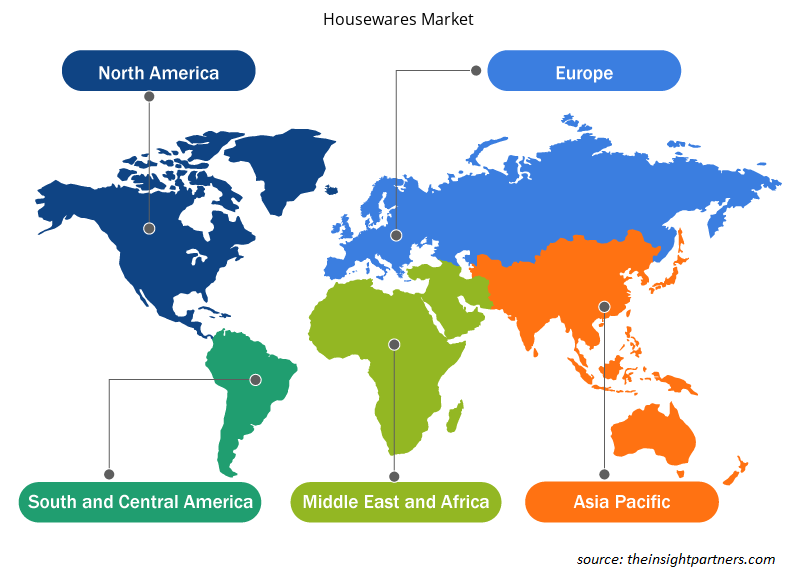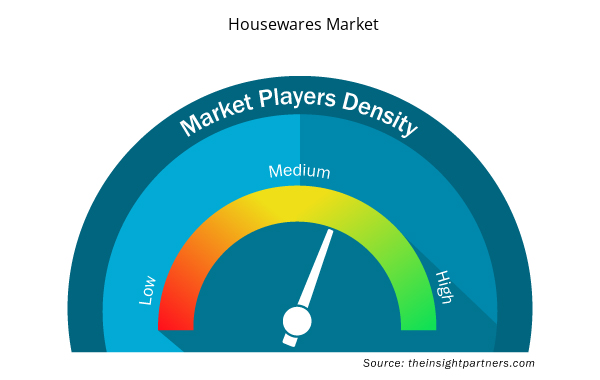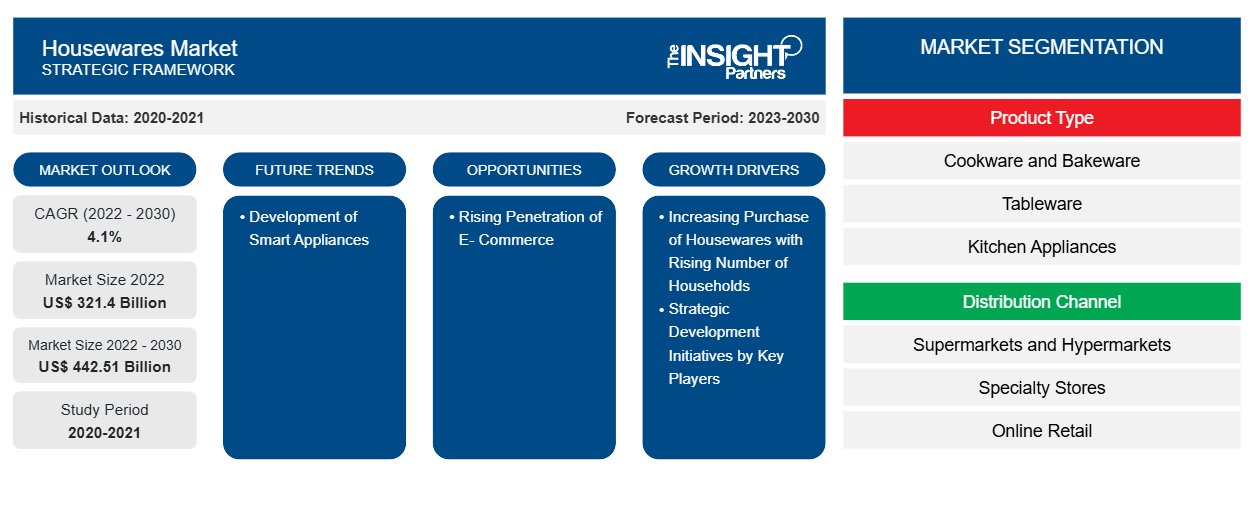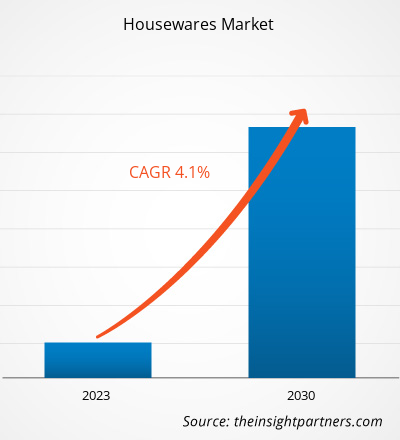[研究报告] 2022 年家庭用品市场规模价值 3214.0 亿美元,预计到 2030 年将达到 4425.1 亿美元;预计 2022 年至 2030 年的复合年增长率为 4.1%。
市场洞察和分析师观点:
家庭用品是家庭内部用于烹饪、烘焙和整理家居等用途的产品和物品。由于生活方式的改变和在家中度过的时间增加等因素,家庭用品市场一直在稳步增长,这引发了对实用且美观的家庭用品的需求。在 COVID-19 疫情期间,人们在家中度过的时间更多,并投资改善居住空间。此外,电子商务和在线购物平台的兴起使消费者更容易在家中获得和购买各种家庭用品。这些因素,再加上家庭用品公司提供的创新设计和可持续选择,有利于家庭用品市场的扩张。
增长动力和挑战:
生活方式的动态变化和双收入家庭的增加导致家庭可支配收入激增,生活水平提高。随着可支配收入的增加,消费者在家庭用品和其他支持便利生活的电器上花费大量资金。他们往往愿意购买新产品,因为这些产品风格独特,符合他们的个性,从而导致购买频率更高。此外,单身家庭数量的激增引发了对家庭改造的需求,从而推动了对厨房用具、炊具、烤盘、餐具和浴室必需品等家庭用品的需求。
此外,城市化进程的加快也推动了对住宅单元的需求,并最终推动了对家居用品的需求。根据美国人口普查局和美国住房和城市发展部的数据,美国在 2021 年完成了约 130 万套住房的建设,而正在建设中的住房约有 170 万套。同样,欧洲国家城市化进程的加快也产生了对住宅的巨大需求。根据欧盟委员会的数据,2015 年至 2021 年,欧盟的住宅建筑许可证数量增长了 42.3%。2021 年,法国、德国和波兰在欧洲的住宅建设开工量最多。因此,各国住房建设的增加进一步推动了对家居用品的需求。因此,随着家庭数量的增加,家庭用品购买量的增加推动了家居用品市场的增长。
然而,由于发展中国家存在许多尚未开发的小型私营企业和街头小贩,家庭用品市场高度分散和混乱。据《商业标准》杂志发表的一篇文章称,截至 2020 年,印度 80% 的厨具市场处于混乱状态。当地小企业使用劣质原材料制造炊具、烤盘、浴室配件和餐具等家庭用品。使用劣质原材料会导致最终产品质量低劣,容易损坏。此外,制造商以低成本提供这些产品;因此,大多数消费者会因为价格实惠和容易获得而购买这些产品。这一因素导致主要家庭用品制造商的客户群萎缩。
此外,在无组织的家庭用品市场中,当地制造商往往不遵守监管标准,这可能会引发质量问题,并影响消费者对家庭用品的看法。此外,假冒产品的泛滥也会损害主要参与者的品牌形象。因此,运营和监管的不统一阻碍了家庭用品市场的增长。
定制此报告以满足您的需求
您可以免费定制任何报告,包括本报告的部分内容、国家级分析、Excel 数据包,以及为初创企业和大学提供优惠和折扣
- 获取此报告的关键市场趋势。这个免费样品将包括数据分析,从市场趋势到估计和预测。
报告细分和范围:
全球家庭用品市场根据产品类型、分销渠道和地理位置进行细分。根据产品类型,市场分为炊具和 烤盘、餐具、厨房用具、浴室必需品等。根据分销渠道,市场分为超市和大卖场、专卖店、在线零售等。根据地理位置,全球家庭用品市场大致分为北美、欧洲、亚太地区、中东和非洲以及南美和中美洲。
节段分析:
根据产品类型,家庭用品市场分为炊具和烤盘、餐具、厨房用具、浴室必需品等。餐具部分预计在 2022-2030 年期间实现最高复合年增长率。餐具部分包括陶器、餐具、玻璃器皿和餐具等产品。家庭用品市场对餐具的需求激增可归因于 COVID-19 大流行期间就餐习惯的转变。随着越来越多的人在家就餐,人们开始关注美观和实用的餐具,因为它可以增强家庭就餐体验。从日常用餐到特殊聚会,消费者都在寻找能够提升就餐体验的餐具套装。此外,对独特和手工设计的日益欣赏在推动餐具需求方面发挥了重要作用。消费者越来越被手工制作和艺术灵感的餐具所吸引,这些餐具为他们的用餐环境带来了一丝个性和个性。因此,向更加个性化和视觉上引人注目的餐具选择的转变促进了家庭用品市场餐具部分的进步。 Vivo - Villeroy & Boch Group、Corelle、Pyrex、Luminarc 和 Schott Zwiesel 是餐具市场上几家知名企业。
区域分析:
家庭用品市场分为五个主要区域:北美、欧洲、亚太地区、南美和中美以及中东和非洲。2022 年,亚太地区在全球家庭用品市场中占据主导地位,因为该地区的市场价值为 1206.3 亿美元。欧洲是第二大贡献者,占全球市场份额的 23% 以上。预计 2022-2030 年亚太地区的复合年增长率将超过 5%。中产阶级人口的城市化和可支配收入的不断增长是推动对现代和便捷家庭用品(包括先进的厨房用具和时尚餐具)需求的主要因素。
家庭用品市场区域洞察
Insight Partners 的分析师已详尽解释了预测期内影响家庭用品市场的区域趋势和因素。本节还讨论了北美、欧洲、亚太地区、中东和非洲以及南美和中美洲的家庭用品市场细分和地理位置。

- 获取家庭用品市场的区域特定数据
家庭用品市场报告范围
| 报告属性 | 细节 |
|---|---|
| 2022 年市场规模 | 3214亿美元 |
| 2030 年的市场规模 | 4425.1亿美元 |
| 全球复合年增长率(2022 - 2030 年) | 4.1% |
| 史料 | 2020-2021 |
| 预测期 | 2023-2030 |
| 涵盖的领域 | 按产品类型
|
| 覆盖地区和国家 | 北美
|
| 市场领导者和主要公司简介 |
|
市场参与者密度:了解其对商业动态的影响
家庭用品市场正在快速增长,这得益于终端用户需求的不断增长,而这些需求又源于消费者偏好的不断变化、技术进步以及对产品优势的认识不断提高等因素。随着需求的增加,企业正在扩大其产品范围,进行创新以满足消费者的需求,并利用新兴趋势,从而进一步推动市场增长。
市场参与者密度是指在特定市场或行业内运营的企业或公司的分布情况。它表明在给定市场空间中,相对于其规模或总市场价值,有多少竞争对手(市场参与者)存在。
在家庭用品市场运营的主要公司有:
- 布拉德肖家居公司
- 丹比陶器有限公司
- HF Coors 公司
- 宜家控股有限公司
- 赫兹勒制造公司
免责声明:上面列出的公司没有按照任何特定顺序排列。

- 获取家庭用品市场顶级关键参与者概览
COVID-19 疫情影响:
由于制造工厂停工、劳动力短缺、供应链中断和金融不稳定,COVID-19 疫情最初阻碍了全球家庭用品市场的发展。COVID-19 疫情导致经济放缓,各行各业的运营中断,抑制了家庭用品的供应。此外,各种商店都关门了,这限制了家庭用品的销售。尽管如此,随着 2021 年各国取消先前实施的限制,企业开始取得进展。此外,各国政府实施的 COVID-19 疫苗接种运动缓解了这种情况,导致全球商业活动增加。包括家庭用品市场在内的多个市场在解除封锁和行动限制后均报告了增长。
竞争格局和重点公司:
Bradshaw Home Inc、Denby Pottery、HF Coors Co Inc、Inter Ikea Holding Bv、Hutzler Manufacturing Co Inc、TTK Prestige Ltd、Newell Brands Inc、BSH Hausgerate GmbH、Kohler Co 和 Haier US Appliance Solutions Inc 是全球家庭用品市场的知名参与者。
- 历史分析(2 年)、基准年、预测(7 年)及复合年增长率
- PEST 和 SWOT 分析
- 市场规模价值/数量 - 全球、区域、国家
- 行业和竞争格局
- Excel 数据集



Report Coverage
Revenue forecast, Company Analysis, Industry landscape, Growth factors, and Trends

Segment Covered
This text is related
to segments covered.

Regional Scope
North America, Europe, Asia Pacific, Middle East & Africa, South & Central America

Country Scope
This text is related
to country scope.
常见问题
Based on distribution channel, the housewares market is segmented into supermarkets and hypermarkets, specialty stores, online retail, and others. Buying convenience and accessibility are the significant characteristics of supermarkets and hypermarkets. These stores are typically located in areas that are easily accessible by the masses, making it convenient for customers to check and purchase housewares alongside completing the planned shopping. Many supermarkets and hypermarkets have introduced their private label houseware brands, offering consumers superior-quality products at competitive prices. Supermarkets and hypermarkets have extended operating hours, which allows customers to shop at convenient hours. Also, these larger retail establishments often have the advantage of bulk purchasing power, which allows them to offer products at competitive prices. Moreover, supermarkets and hypermarkets tend to stock a variety of houseware in different product types, brands, and varieties, providing customers with a more elaborate range of selections. Walmart, Costco Wholesale Corporation, Tesco, Target, and Bed Bath & Beyond are some of the supermarkets and hypermarket stores offering houseware products.
The major players operating in the global housewares market are Bradshaw Home Inc, Denby Pottery, HF Coors Co Inc, Inter Ikea Holding Bv, Hutzler Manufacturing Co Inc, TTK Prestige Ltd, Newell Brands Inc, BSH Hausgerate GmbH, Kohler Co, and Haier US Appliance Solutions Inc among others.
Dynamic changes in lifestyle and the rising dual income families led to an upsurge in disposable incomes and improved living standards of households. With increasing disposable incomes, consumers spend significant amounts on housewares and other appliances supporting convenient living. They are often willing to purchase new products owing to their unique styles, which appeal to their individuality, resulting in a higher buying frequency. Moreover, a burgeoning number of single-person households triggers the need for home modifications, thereby driving the demand for housewares such as kitchen appliances, cookware, bakeware, tableware, and bathroom essentials. Further, a rise in urbanization has been bolstering the demand for residential units and, ultimately, homewares products. As per the US Census Bureau and the US Department of Housing and Urban Development, the US completed construction of ~1,337,800 housing units in 2021, whereas construction of 1,702,000 housing units was in progress. Similarly, rising urbanization in European countries has created a huge demand for residential housing. For instance, according to the European Commission, between 2015 to 2021, residential building permits increased by 42.3%. In 2021, France, Germany, and Poland had the most residential construction starts in Europe. Thus, the increasing construction of housing units across various countries further boosts the demand for housewares.
Smart appliances can be operated using smartphones or tablets connected via Bluetooth, near–field communication (NFC), or Wi-Fi. These technologies allow users to control their smart appliances via an app. Manufacturers are continuously modifying and developing smart home appliances to support easy lifestyles, which especially appeals to tech-savvy consumers. Well-known brands have been developing devices with automation and hi-tech features for smart homes. Moreover, voice assistants and artificial intelligence (AI) are bringing significant evolution into smart housewares.
Energy-saving appliances, notifications enabled on connected devices, and Wi-Fi capabilities are the key functional upgrades in smart kitchen appliances. For example, smart microwaves can seamlessly download cooking instructions, read barcodes on food products, and offer AI voice assistants to enable a completely hands-free experience. Whirlpool, in January 2022, announced that some of its smart, Wi-Fi-connected microwave would be upgraded to incorporate an air fry mode via a software update to replicate the crispy reheating specifications. Thus, the incorporation of innovative technologies into housewares is likely to bring new trends in the housewares market in the coming years.
Based on product type, the housewares market is categorized into cookware and bakeware, tableware, kitchen appliances, bathroom essentials, and others. The tableware segment is expected to register the highest CAGR during 2022–2030. The tableware segment includes products such as crockery, cutlery, glassware, and serveware. A surge in demand for tableware in the housewares market can be attributed to transformed dining habits during the COVID-19 pandemic. With more people dining at home, people have started focusing on aesthetic and functional tableware, as it enhances home dining experiences. From everyday meals to special gatherings, consumers are looking for tableware sets that elevate their dining experience. Furthermore, the growing appreciation for unique and artisanal designs plays a significant role in driving the demand for tableware. Consumers are increasingly drawn to handcrafted and artistically inspired tableware pieces that bring a touch of individuality and personality to their dining settings. Thus, a shift toward more personalized and visually striking tableware choices has contributed to the progress of the housewares market for the tableware segment. Vivo - Villeroy & Boch Group, Corelle, Pyrex, Luminarc, and Schott Zwiesel are a few of the prominent players operating in the market for tableware.
Trends and growth analysis reports related to Consumer Goods : READ MORE..
The List of Companies - Houseware Market
- Bradshaw Home Inc
- The Denby Pottery Co Ltd
- HF Coors Co Inc
- Inter Ikea Holding Bv
- Hutzler Manufacturing Co Inc
- TTK Prestige Ltd, Newell Brands Inc
- BSH Hausgerate Gmbh
- Kohler Co
- Haier US Appliance Solutions Inc.
The Insight Partners performs research in 4 major stages: Data Collection & Secondary Research, Primary Research, Data Analysis and Data Triangulation & Final Review.
- Data Collection and Secondary Research:
As a market research and consulting firm operating from a decade, we have published and advised several client across the globe. First step for any study will start with an assessment of currently available data and insights from existing reports. Further, historical and current market information is collected from Investor Presentations, Annual Reports, SEC Filings, etc., and other information related to company’s performance and market positioning are gathered from Paid Databases (Factiva, Hoovers, and Reuters) and various other publications available in public domain.
Several associations trade associates, technical forums, institutes, societies and organization are accessed to gain technical as well as market related insights through their publications such as research papers, blogs and press releases related to the studies are referred to get cues about the market. Further, white papers, journals, magazines, and other news articles published in last 3 years are scrutinized and analyzed to understand the current market trends.
- Primary Research:
The primarily interview analysis comprise of data obtained from industry participants interview and answers to survey questions gathered by in-house primary team.
For primary research, interviews are conducted with industry experts/CEOs/Marketing Managers/VPs/Subject Matter Experts from both demand and supply side to get a 360-degree view of the market. The primary team conducts several interviews based on the complexity of the markets to understand the various market trends and dynamics which makes research more credible and precise.
A typical research interview fulfils the following functions:
- Provides first-hand information on the market size, market trends, growth trends, competitive landscape, and outlook
- Validates and strengthens in-house secondary research findings
- Develops the analysis team’s expertise and market understanding
Primary research involves email interactions and telephone interviews for each market, category, segment, and sub-segment across geographies. The participants who typically take part in such a process include, but are not limited to:
- Industry participants: VPs, business development managers, market intelligence managers and national sales managers
- Outside experts: Valuation experts, research analysts and key opinion leaders specializing in the electronics and semiconductor industry.
Below is the breakup of our primary respondents by company, designation, and region:

Once we receive the confirmation from primary research sources or primary respondents, we finalize the base year market estimation and forecast the data as per the macroeconomic and microeconomic factors assessed during data collection.
- Data Analysis:
Once data is validated through both secondary as well as primary respondents, we finalize the market estimations by hypothesis formulation and factor analysis at regional and country level.
- Macro-Economic Factor Analysis:
We analyse macroeconomic indicators such the gross domestic product (GDP), increase in the demand for goods and services across industries, technological advancement, regional economic growth, governmental policies, the influence of COVID-19, PEST analysis, and other aspects. This analysis aids in setting benchmarks for various nations/regions and approximating market splits. Additionally, the general trend of the aforementioned components aid in determining the market's development possibilities.
- Country Level Data:
Various factors that are especially aligned to the country are taken into account to determine the market size for a certain area and country, including the presence of vendors, such as headquarters and offices, the country's GDP, demand patterns, and industry growth. To comprehend the market dynamics for the nation, a number of growth variables, inhibitors, application areas, and current market trends are researched. The aforementioned elements aid in determining the country's overall market's growth potential.
- Company Profile:
The “Table of Contents” is formulated by listing and analyzing more than 25 - 30 companies operating in the market ecosystem across geographies. However, we profile only 10 companies as a standard practice in our syndicate reports. These 10 companies comprise leading, emerging, and regional players. Nonetheless, our analysis is not restricted to the 10 listed companies, we also analyze other companies present in the market to develop a holistic view and understand the prevailing trends. The “Company Profiles” section in the report covers key facts, business description, products & services, financial information, SWOT analysis, and key developments. The financial information presented is extracted from the annual reports and official documents of the publicly listed companies. Upon collecting the information for the sections of respective companies, we verify them via various primary sources and then compile the data in respective company profiles. The company level information helps us in deriving the base number as well as in forecasting the market size.
- Developing Base Number:
Aggregation of sales statistics (2020-2022) and macro-economic factor, and other secondary and primary research insights are utilized to arrive at base number and related market shares for 2022. The data gaps are identified in this step and relevant market data is analyzed, collected from paid primary interviews or databases. On finalizing the base year market size, forecasts are developed on the basis of macro-economic, industry and market growth factors and company level analysis.
- Data Triangulation and Final Review:
The market findings and base year market size calculations are validated from supply as well as demand side. Demand side validations are based on macro-economic factor analysis and benchmarks for respective regions and countries. In case of supply side validations, revenues of major companies are estimated (in case not available) based on industry benchmark, approximate number of employees, product portfolio, and primary interviews revenues are gathered. Further revenue from target product/service segment is assessed to avoid overshooting of market statistics. In case of heavy deviations between supply and demand side values, all thes steps are repeated to achieve synchronization.
We follow an iterative model, wherein we share our research findings with Subject Matter Experts (SME’s) and Key Opinion Leaders (KOLs) until consensus view of the market is not formulated – this model negates any drastic deviation in the opinions of experts. Only validated and universally acceptable research findings are quoted in our reports.
We have important check points that we use to validate our research findings – which we call – data triangulation, where we validate the information, we generate from secondary sources with primary interviews and then we re-validate with our internal data bases and Subject matter experts. This comprehensive model enables us to deliver high quality, reliable data in shortest possible time.


 获取此报告的免费样本
获取此报告的免费样本